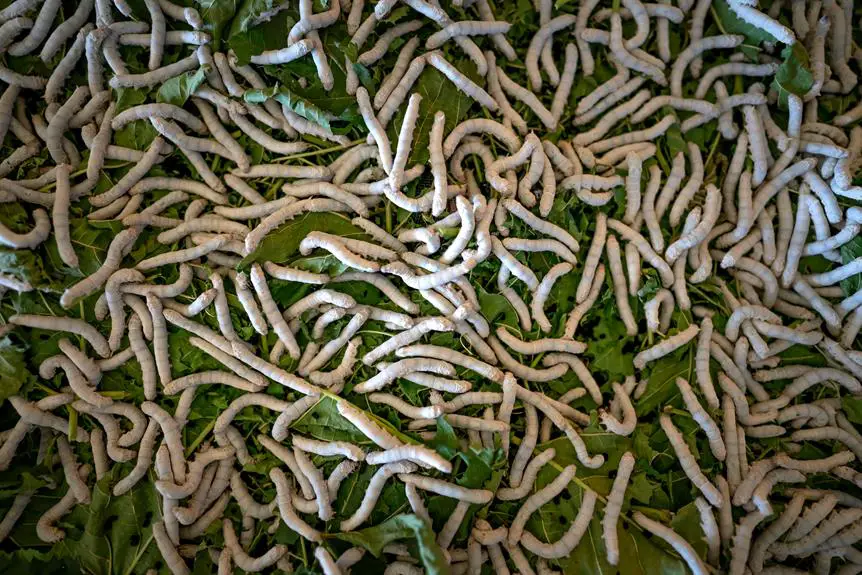When you consider the beauty of damask fabric, it's easy to overlook the environmental costs tied to its production. Deforestation for mulberry plantations disrupts local ecosystems, while the use of pesticides and fertilizers introduces harmful pollutants into water sources. You might not realize that the carbon footprint from cultivation and manufacturing processes exacerbates climate change. Yet, there's a growing movement towards sustainable practices that could reshape the industry. What changes are being made, and how can they influence the future of damask production?
Table of Contents
Overview of Damask Production
Damask production involves weaving intricate patterns into fabric, primarily using silk, which creates a luxurious textile sought after for its beauty and durability.
This process combines artistry and craftsmanship, where skilled artisans meticulously create designs that often feature floral or geometric motifs. You'll find that each piece tells a story, showcasing cultural influences and traditional techniques passed down through generations.
The production begins with the careful selection of high-quality silk threads, ensuring the fabric's strength and sheen. These threads are then dyed using various methods to achieve vibrant colors. Next, the weaving process takes place on specialized looms, where the patterns emerge through a combination of warp and weft threads.
You might be surprised to learn that damask isn't just limited to clothing; it's also used in table linens, upholstery, and draperies, enhancing the elegance of any space.
The versatility of damask fabric allows it to adapt to both modern and classical settings, making it a timeless choice for decorators and designers alike.
Deforestation and Land Use
Deforestation for silk production impacts ecosystems and local communities, as forests are cleared to make way for mulberry plantations that feed silkworms. This loss of forested areas disrupts habitats, threatening biodiversity and endangering species that rely on these ecosystems.
You mightn't realize that when trees are removed, soil erosion often increases, leading to degraded land that can't support other forms of agriculture.
As these plantations expand, local communities face challenges too. Traditional livelihoods, such as hunting and gathering, become compromised, forcing people to adapt to new economic realities. The shift to monoculture farming reduces food variety, impacting local diets.
Plus, as farmers focus solely on mulberry production, they often neglect sustainable practices that preserve soil health.
You might want to consider the long-term consequences of this land-use shift. By prioritizing silk production over forest conservation, we risk not only the loss of valuable natural resources but also the cultural heritage of communities that depend on them.
Sustainable practices that balance silk production with environmental stewardship could help mitigate these impacts, ensuring that both ecosystems and local communities thrive together.
Water Pollution Concerns
As mulberry plantations expand, the increased use of pesticides and fertilizers can lead to significant water pollution, affecting nearby rivers and streams essential for both ecosystems and local communities. When these chemicals wash into waterways, they can disrupt aquatic life and contaminate drinking water sources. You mightn't realize how these pollutants can harm fish populations, damage habitats, and reduce biodiversity.
Additionally, the runoff from these plantations often carries harmful algal blooms, which can produce toxins that endanger wildlife and humans alike. If you live near affected areas, you might notice changes in water quality, including foul odors or unusual colors, signaling danger. Communities that rely on these water sources for fishing or recreation may find their livelihoods threatened.
It's crucial to understand that the problem doesn't stop there. The long-term accumulation of pollutants can create a cycle of degradation that affects soil health and agricultural productivity.
To combat these issues, you can advocate for sustainable farming practices that minimize chemical use. By supporting eco-friendly approaches, you help protect water quality and ensure a healthier environment for both wildlife and your community.
Carbon Emissions and Climate Impact
Many don't realize that the production of damask can significantly contribute to carbon emissions and climate change. When you consider the entire process, from growing the raw materials to the weaving and finishing stages, each step releases greenhouse gases. For instance, cultivating the plants often requires heavy machinery, which burns fossil fuels and emits carbon dioxide.
Then there's the energy needed for the manufacturing processes. Factories typically rely on non-renewable energy sources that further increase carbon footprints. The transportation of materials and finished products adds another layer, as trucks and ships contribute to emissions as they move goods across distances.
Additionally, the waste generated during production, if not properly managed, can lead to methane emissions as it decomposes. This is particularly concerning for damask, often produced in bulk, leading to large quantities of waste.
Ultimately, every stage of damask production carries a cost to our climate. By understanding these impacts, you can make more informed choices about the textiles you support and advocate for more environmentally friendly practices within the industry.
Sustainable Practices in Production
While the environmental impact of traditional damask production raises concerns, adopting sustainable practices can significantly reduce these effects and promote a more eco-friendly approach. You can make a difference by implementing several strategies in your production process.
First, consider sourcing organic materials that require fewer pesticides and fertilizers. This not only supports healthier ecosystems but also produces high-quality textiles. Next, adopting water-efficient techniques, such as rainwater harvesting or recycling, can minimize water usage significantly.
Additionally, energy-efficient machinery and renewable energy sources like solar or wind power can drastically lower carbon emissions. You should also explore eco-friendly dyes and finishes that are less harmful to the environment. Lastly, promoting a circular economy by recycling and repurposing fabrics can further reduce waste.
Here's a quick overview of sustainable practices:
| Sustainable Practice | Benefits |
|---|---|
| Organic material sourcing | Reduces chemical use |
| Water-efficient techniques | Lowers water consumption |
| Energy-efficient machinery | Decreases carbon footprint |
| Eco-friendly dyes and finishes | Minimizes environmental harm |
| Circular economy initiatives | Reduces textile waste |
Frequently Asked Questions
What Are the Historical Origins of Damask Fabric?
Damask fabric originated in the Middle Ages, primarily in the Middle East. You'll find its intricate patterns woven into silk, linen, and cotton, showcasing craftsmanship from regions like Damascus, which gave the fabric its name.
How Does Damask Compare to Other Fabrics Environmentally?
When you compare damask to other fabrics, you'll find it often requires less water and fewer chemicals in production. This can make it a more sustainable choice, depending on the specific production methods used.
What Are Alternative Uses for Damask Beyond Textiles?
You can use damask for home decor, like tablecloths and curtains, or create beautiful upholstery for furniture. It also works well in crafting projects, adding a touch of elegance to various artistic endeavors.
How Can Consumers Identify Sustainably Produced Damask?
To identify sustainably produced damask, look for certifications like GOTS or OEKO-TEX. Check brand transparency about sourcing and production methods. Research companies' environmental practices, and choose those committed to ethical and sustainable textile production.
What Organizations Advocate for Sustainable Damask Production?
You can explore organizations like the Sustainable Textile Coalition and the Global Organic Textile Standard. They advocate for sustainable practices in textile production, including damask, ensuring transparency and eco-friendly methods throughout the supply chain.
- How Does Ring Spun Cotton Affect Garment Fit and Shape Retention? - August 13, 2024
- What Are the Challenges in Producing Ring Spun Cotton? - August 13, 2024
- Is Ring Spun Cotton Suitable for Plus-Size Clothing? - August 13, 2024




